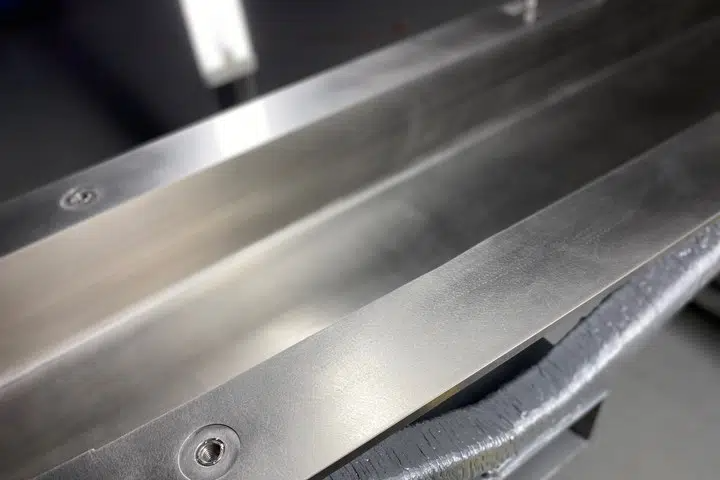Invar facesheets and backing structures are candidates for large-format 3D printing to more quickly and efficiently produce aerostructures tooling.
As the use of composites has soared in commercial aircraft in the last decade, so too has the size of parts being converted from metals to composites — mostly to carbon fiber-reinforced epoxy prepreg. That has made it more challenging to find tooling options that can be produced in large sizes relatively affordably and quickly.
One challenge is that typical carbon fiber composite prepreg has a very low coefficient of (linear) thermal expansion (CLTE or CTE). As composite aerostructure parts get larger, so too must the tools in which they’re formed. However, if a tool material has a higher CLTE than the material being molded in it, then final part dimensions can deviate unacceptably from specifications. In tools with trapped/undercut features, the cured part could actually break during cooling and/or demolding, or could become die-locked in the tool.
Consequently, prototype and low-volume production tools for traditional composite aerostructure parts have typically been fabricated from hand layup/autoclave-cured carbon fiber/epoxy prepreg itself, with higher volume production tools typically machined from blocks or plates of Invar, a nickel-iron alloy renowned for its low CLTE. Both tool materials are expensive and can have long lead times, which has caused many in the industry to seek alternatives in large-format additive manufacturing (LFAM).
As reported in the CW December 2020 issue (see Learn More), one option that’s been tried is to 3D print a thermoplastic composite core and then apply conventional carbon fiber/epoxy tooling prepreg facesheets to the core. This entire assembly is then autoclave cured together (without need for adhesives) to produce a tool. While this approach may prove viable to mold prototype and low-volume production parts, high-production volumes still require a more durable option. That option is now available in the form of mold facesheets and backing structures fabricated with 3D-printed Invar.
Gas-Metal Arc Welding
Presently, there are several printing technologies for both small- and large-format metal additive manufacturing. Some systems use laser-fused metal powders, with or without a binder (which must be flashed off in a post-print bake cycle). Another technology option is wire-arc additive manufacturing (WAAM). Generally, WAAM systems combine metal (in wire form), a gas-metal arc welding (GMAW) power source mounted on an industrial robot, and a numerically controlled (NC) multi-axis positioner on which the build takes place.
Unlike powder-metal AM technologies, WAAM permits a much larger build area, offers much faster deposition rates (5-10 pounds/2.3-4.5 kilograms per hour) and, overall, uses less expensive material. Versus machining plates/blocks of metal or castings, WAAM can reduce lead times from months to weeks, helping manufacturers bring parts to market faster. It also significantly increases design freedom and part-consolidation opportunities. For example, rather than machining a facesheet and then building a separate backing structure for an aerostructure tool, the entire tool with integral backing structure can be printed in a single build with less waste/scrap. Additionally, the ability to print lattice structures can lead to lighter printed tools, which makes them easier to ship and store, and improves thermal properties, reducing autoclave heat-up/cool-down cycles.
Currently, WAAM’s biggest limitations are the physical reach of the robots used and the size of the room that encloses the printing cell in which the build takes place. On the other hand, this cell does not need to be in a cleanroom, as with many metal AM processes. The only room requirements are an air handling system to collect fumes and localized shielding of the gas source.


As with 3D-printed plastic parts or tools, WAAM produces a near-net shape part or tool whose surface is striated and bumpy (in this case, from the weld beads). Thus, post-print machining of the molding surface is needed to bring WAAM-fabricated tools into dimensional compliance.
Supply Integration
Several companies sell large-format WAAM systems, although very few offer printing services. One of the latter is the Additive Solutions unit of Lincoln Electric Co. (Cleveland, Ohio, U.S.), which offers custom WAAM printing services using the company’s own GMAW-based WAAM technology on 20 machines at its 75,000-square-foot/6,968-square-meter facility in Cleveland, Ohio, U.S. Post-process machining of 3D-printed components is conducted at its Baker Industries (Macomb, Mich., U.S.) subsidiary, which provides tool engineering and fabrication services for automotive and aerospace markets, plus custom-machining services.
Lincoln Electric is a long-time supplier of welding and cutting equipment, automation and consumables such as welding wire in various tool steel, stainless, nickel, bronze and aluminum alloys. Reportedly, the company has been exploring metal AM for more than a decade. Lincoln Additive Solutions launched in 2019 and began printing with Invar wire in 2020. Metal additive manufacturing has long been used to prototype parts and to repair or replace legacy parts, but now — with the addition of Invar wire — it also can be used to produce aerospace tooling.
“What’s different about Lincoln Electric is that we’re in control of the entire process, from start to finish, since we manufacture power sources, welding equipment, flexible automation [robots and positioners], post-print subtractive processes [machining] and our own wire feedstock,” explains Mike Wangelin, business development/sales manager for Lincoln’s Additive Solutions. “Not only do we have decades of experience in welding and advanced automation, but we also own and develop our own additive software, which not only sections a 3D model into layers to generate the deposition path, but also programs the robot and positioner. Our SculptPrint operating system was originally developed to drive complex 5-axis NC machining and has since been adapted to AM. Since we own the software, as more is learned about the WAAM process and efficiencies are gained, immediate updates are made. Backed by the power of our large parent corporation, we’re able to invest in each advanced technology segment along the way to drive the whole WAAM process forward.”
“What’s different about Lincoln Electric is that we’re in control of the entire process, from start to finish, since we manufacture power sources, welding equipment, flexible automation [robots and positioners], post-print subtractive processes [machining] and our own wire feedstock,” explains Mike Wangelin, business development/sales manager for Lincoln’s Additive Solutions. “Not only do we have decades of experience in welding and advanced automation, but we also own and develop our own additive software, which not only sections a 3D model into layers to generate the deposition path, but also programs the robot and positioner. Our SculptPrint operating system was originally developed to drive complex 5-axis NC machining and has since been adapted to AM. Since we own the software, as more is learned about the WAAM process and efficiencies are gained, immediate updates are made. Backed by the power of our large parent corporation, we’re able to invest in each advanced technology segment along the way to drive the whole WAAM process forward.”
Proof is in the Printing
Lincoln reports that it has already produced and delivered its first WAAM Invar tool to an aerospace customer. While the production tool is described as “traditional in design,” by 3D printing its facesheet in Invar, Wangelin says the fabrication process was simplified significantly and overall cycle time was reduced. Lincoln also delivered several carbon-steel production tools to aerospace customers in 2020.
Currently, Lincoln is collaborating with The Boeing Co. (Seattle, Wash., U.S.) on a project focused on incorporating an Invar backing structure into the 3D print to produce a fully integral 3D-printed tool for a composite part on an aerospace program under development at Wisk Aero LLC (Mountain View, Calif., U.S.). Wisk, which is backed by Boeing and Kitty Hawk Corp. (Mountain View, Calif., U.S.), is developing commercial aircraft for the urban air mobility (UAM) market.
“Boeing continues to be an industry leader in additive manufacturing technology development and integration, but we also acknowledge the need for tool engineering’s philosophy to evolve because traditional tool design hasn’t capitalized on newer technical capabilities,” explains Melissa Orme, Boeing Additive Manufacturing vice president. “We recognized the technical expertise of Lincoln Electric and their commitment to rapidly advancing wire-feed additive manufacturing technology by collaborating with them on the Wisk project.”
Teams from Boeing Research & Technology and Boeing Additive Manufacturing proposed the development of a composite cure tool that pushed the envelope of WAAM technology to the next level and provided design optimization support to help Lincoln develop the fully 3D-printed Invar composite cure tool.
“Tooling is the last item needed before a production run, so there’s always schedule pressure to produce tools as quickly and affordably as possible,” adds Wangelin. “As aerostructure parts become more complex, and tooling lead times and costs start to come down because of AM, Lincoln Additive Solutions can offer a real advantage by cutting production and delivery times — especially for complex tools. Add to that our focus on design for additive collaboration and our work in topology optimization, and we have something that will be of great interest to aerospace customers.”
“The Boeing and Lincoln Electric collaboration to advance state-of-the-art WAAM technology is a revolutionary achievement and a testament to both companies’ commitment to innovative technology development,” adds Michael Matlack, Boeing associate technical fellow. After finish machining at Baker Aerospace, the WAAM cure tool will undergo functional testing at Boeing’s St. Louis, Mo., U.S., facility to document dimensional stability, surface roughness and vacuum integrity.


